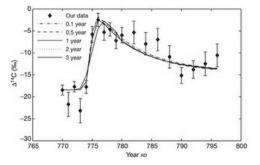November 29, 2012 report
Astrophysicists suggest solar flare could explain carbon-14 bump in AD 774

(Phys.org)—Astrophysicists Adrian Melott and Brian Thomas of the University of Kansas and Washburn University respectively, have published a "brief communication arising" piece in the journal Nature suggesting that the conclusions of a team of Japanese researchers from Nagoya University regarding the source of a carbon-14 bump in AD 774-775 were in error. The Japanese team published an article earlier this year, also in Nature in which they suggested the brief bump in carbon-14 as evidenced by tree samples, was likely not the result of solar flares or a supernova.
In their paper, the team from Nagoya described their results in measuring the amount of carbon-14 in Japanese cedar tree rings that represented the years AD 750 to AD 820 with one and two year resolution. In so doing, they found a rapid, 12 percent increase in the amount of carbon-14, over the period AD 774-775, indicating that an extremely energetic event of unknown origin had occurred during that time period. They noted that the bump was approximately 20 times that seen from normal solar activity and for that reason ruled out a solar flare as a possible cause. They also ruled out a supernova as a likely source as it would have been seen and noted by people living at the time.
Carbon-14 is a variant of normal carbon-12 and tends to show up on planet Earth when cosmic particles strike the atmosphere producing showers of neutrons, which in turn strike hydrogen nuclei causing a reaction that results in the creation of carbon-14. That carbon-14 then falls and in this case, abundant amounts landed on some cedar trees in Japan 1,238 years ago. The Japanese team suggest that if such a bump was due to a solar flare it would have had to have been thousands of times larger than any that has ever been recorded, making it an unlikely possibility.
Melott and Thomas disagree and write that it's possible a solar flare could have caused the bump if it shot out in blobs, rather than as a mass ejection that spewed cosmic particles in all directions. If that were they case they say, a solar flare just 10 or 20 times the size of the largest ever recorded (the Carrington event of 1859) could very easily explain the carbon-14 bump during that time period.
More information: Causes of an ad 774–775 14C increase, Nature, 491, E1–E2 (29 November 2012) doi:10.1038/nature11695
Abstract
Atmospheric 14C production is a potential window into the energy of solar proton and other cosmic ray events. It was previously concluded that 14C results from AD 774–775 would require solar events that were orders of magnitude greater than known past events. We find that the coronal mass ejection energy based on 14C production is much smaller than claimed in ref. 1, but still substantially larger than the maximum historical Carrington Event of 1859. Such an event would cause great damage to modern technology, and in view of recent confirmation of superflares on solar-type stars, this issue merits attention.
Journal information: Nature
© 2012 Phys.org



















